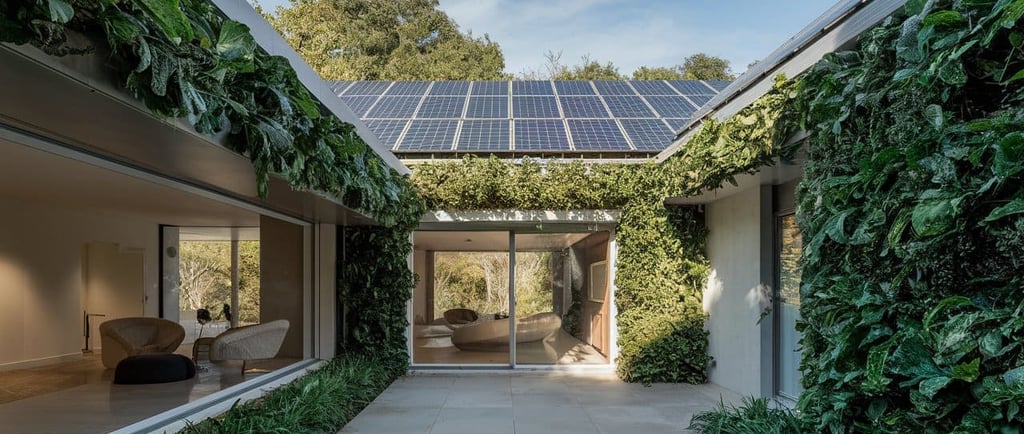Vanguard Sustainable Architecture and Regeneration: Our Building Promise
This article explores how luxury hospitality can become a driver of regeneration and sustainability. Beyond building from scratch, we champion the reuse of existing land and infrastructure, giving them new life under principles of revolutionary architecture and responsible design. Through global examples from the past decade, from medieval forts turned into resorts to office buildings transformed into zero-emission hotels we show that true luxury today means preserving, regenerating, and creating lasting positive impact. This is our promise: to build resorts that care for the planet, honor each place’s history, and deliver unique experiences with purpose.
REGENERATION AND VANGUARD SUSTAINABLE ARCHITECTURE
Michel Eganya
9/14/20255 min read


A New Paradigm in Sustainable Hospitality
Global tourism stands at a turning point: travelers demand greener and more responsible experiences in their destinations . In the face of climate crisis and biodiversity loss, the traditional model of hotel development must reinvent itself. Our concept is born as a revolutionary response: it is based on regeneration and sustainable, forward-thinking architecture to create resorts that not only minimize impact but actively benefit the environment and local communities. Instead of expanding the tourism footprint over pristine ecosystems, we commit to revitalizing already-used land and adapting existing structures, thus fulfilling a dual mission: preserve the environment and honor the history of each place.
Beyond Sustainability: Active Regeneration
We aim to go beyond traditional sustainability (which seeks to do no harm) toward regenerative hospitality, which seeks to do good. This means designing and operating our resorts to achieve a net-positive impact on the environment, communities, and society at large . In practice, regeneration means restoring degraded ecosystems, improving biodiversity, empowering local economies, and celebrating regional culture. As Amanda Ho, co-founder of Regenerative Travel, says, “regeneration is not something you finish; it is a continuous evolution” . This philosophy drives us to constantly innovate, ensuring that each project contributes something valuable to the place it belongs.
Reusing Land & Existing Infrastructure
One of our fundamental pillars is reuse before new construction. When searching for land for a new resort, we prioritize sites already touched by human activity: former facilities, unused buildings, or even existing resorts that can be transformed into our concept. This adaptive reuse strategy brings enormous benefits. On one hand, it avoids the destruction of untouched habitats, easing pressure on sensitive ecosystems. On the other, it is backed by experts as more efficient and with a lower environmental footprint: turning an existing building into a hotel eliminates the massive environmental costs of producing, transporting, and assembling new construction materials . In recent years, more and more hotel developers are embracing this approach for its sustainability, cost, and design appeal .
Adapting existing structures also preserves the character and history of a place. Around the world, many iconic properties have emerged from the transformation of factories, banks, convents, or even disused offices, giving new life to buildings rich in meaning . This practice not only reduces waste and emissions but also offers travelers authentic experiences. It is no coincidence that a four-star boutique hotel in a recycled historic building often outperforms a newly built standard hotel, thanks to its authenticity and sense of place . Today’s travelers seek uniqueness and local identity, a trend that has grown strongly over the past decade . Reusing and regenerating allows us to meet that demand, telling local stories in every resort and connecting guests with the essence of the community.
Sustainable & Revolutionary Architecture
Our architectural promise goes far beyond installing solar panels. In every project we implement cutting-edge design solutions to achieve efficient, self-sufficient, and nature-harmonious buildings. We maximize existing structures, modernizing them without erasing their soul. For example, in the United States, a 50-year-old office block was converted into the country’s first Passive House hotel, preserving the embodied carbon of the original building and achieving a fully zero-emission hotel . Cases like this prove that high-performance sustainable architecture can be integrated into preexisting buildings, drastically lowering ecological footprints.
We also embrace bioclimatic and circular design principles: maximizing natural ventilation and light, reusing local materials, and integrating passive climate control techniques. Our resorts will include renewable energy systems (solar panels, geothermal when viable), on-site water treatment and reuse, and radical circular economy measures such as eliminating single-use plastics. In one leading example, Six Senses achieved a property operating entirely plastic-free, with its own water bottling plant, solar panels, rainwater harvesting, and organic gardens . Similarly, each of our resorts will become a small circular ecosystem: managing waste (ideally converting it into resources), producing part of its food in local gardens, and generating more energy than it consumes wherever possible.
An inspiring example of adaptive reuse: the 14th-century Fort Barwara in India was meticulously transformed into a Six Senses luxury sustainable resort, conserving its historic architecture. In projects like Six Senses Fort Barwara, acclaimed as “an example of architectural responsibility—preserving the past while paving the way for meaningful sustainable luxury experiences” , the power of this philosophy becomes clear. This extraordinary adaptive reuse project meticulously transformed a medieval fortress into a contemporary resort without losing its historical essence . The team restored key heritage features while discreetly integrating modern comforts to maintain authenticity. The result is a balance between cultural heritage and sustainable design. Thick original stone walls provide natural thermal insulation, while hidden clean technologies ensure energy efficiency. In this way, the resort honors the resilience of the old fortress while embedding sustainable measures that continue that tradition of endurance in today’s context .
Innovation with Positive Impact
We believe innovation only reaches its full meaning when it improves the relationship between humans and their environment. That is why we embrace regeneration in all its dimensions—from restoring degraded lands (through reforestation, soil cleaning, or coastal restoration) to empowering local communities through tourism. Each resort becomes a community partner: prioritizing local hiring, sourcing local products, and investing in grassroots projects. In fact, regenerative hospitality aims to create temporary communities between guests and locals, generating cultural and economic exchanges. One clear example is a small hotel in the Colombian Caribbean that, under a regenerative model, founded a community waste initiative, diverting hundreds of tons of waste from landfills and achieving 75–80% less waste than a conventional hotel . Stories like these inspire our practices: every time we build or remodel, we ask ourselves how we can help the place thrive long after our opening.
The last decade has seen a wave of awareness in our industry. International consortiums have begun uniting independent hotels under this regenerative vision, sharing the belief that tourism can and should contribute to healing the planet . Major chains are also beginning to adopt ambitious commitments: pioneering projects include a resort in Norway that will be the world’s first to generate more energy than it consumes, operating fully off-grid and sending zero waste to landfill . These kinds of innovations mark the way forward. Our promise is to be at the forefront of this movement, acting with boldness but also with sensitivity. Every resort we develop will seek to set a new sustainability standard, proving that luxury and care for the planet can walk hand in hand.
Our Promise for the Future
In short, we commit to ensuring that every resort under our concept becomes a model of regeneration and revolutionary sustainable architecture. This means we will not build by destroying, but by regenerating. We will leverage what already exists—be it a building with history or land already intervened—and reinvent it under green principles, minimizing the carbon footprint of construction and operations. We will measure ourselves not only by the comfort we provide to our guests, but also by the tangible improvements in the natural and social environments we integrate into.
By staying with us, our guests can be confident their visit contributes to a greater purpose. Every reused building is a testimony of sustainability, every ecological technique implemented is a step toward a healthier planet, and every collaboration with the local community is a bond that enriches all. In a world in need of hopeful initiatives, we want to be a beacon: proving it is possible to build today the resorts of tomorrow without compromising the future of generations to come. This is our promise when we build, and the legacy we aim to leave in every destination we touch.
Sources
CNBC: Travelers demand more sustainable experiences in tourism
Hospitality Net: Regenerative hospitality as a net-positive model
Interview with Amanda Ho, Regenerative Travel
Boutique Hotel News: Environmental benefits of adaptive reuse
Boutique Hotel News: Developers embracing adaptive reuse for cost and design appeal
Boutique Hotel News: Examples of properties transformed from factories, banks, convents
Hotel News Now: Boutique hotels in recycled historic buildings outperforming new builds
Hotel News Now: Growing traveler demand for uniqueness and local identity
Passive House project: Conversion of office building into first zero-emission hotel in the US
Six Senses case: Plastic-free operations, water bottling, solar, organic gardens
Six Senses Fort Barwara: Architectural responsibility in adaptive reuse
Six Senses Fort Barwara project description
Six Senses Fort Barwara: Sustainable measures in restored heritage walls
Regenerative Travel case: Colombian Caribbean hotel reducing waste by 75–80%
Regenerative Travel: Independent hotels consortium with regenerative philosophy
CNBC: Norwegian resort generating more energy than it consumes


Show us your support by Buying us a coffee here:
© 2025. All rights reserved, EIR Resorts


Follow us on:
EIR is a regenerative hospitality brand built around people, nature and long-term stewardship.
We build slowly, with care and intention.
Explore
